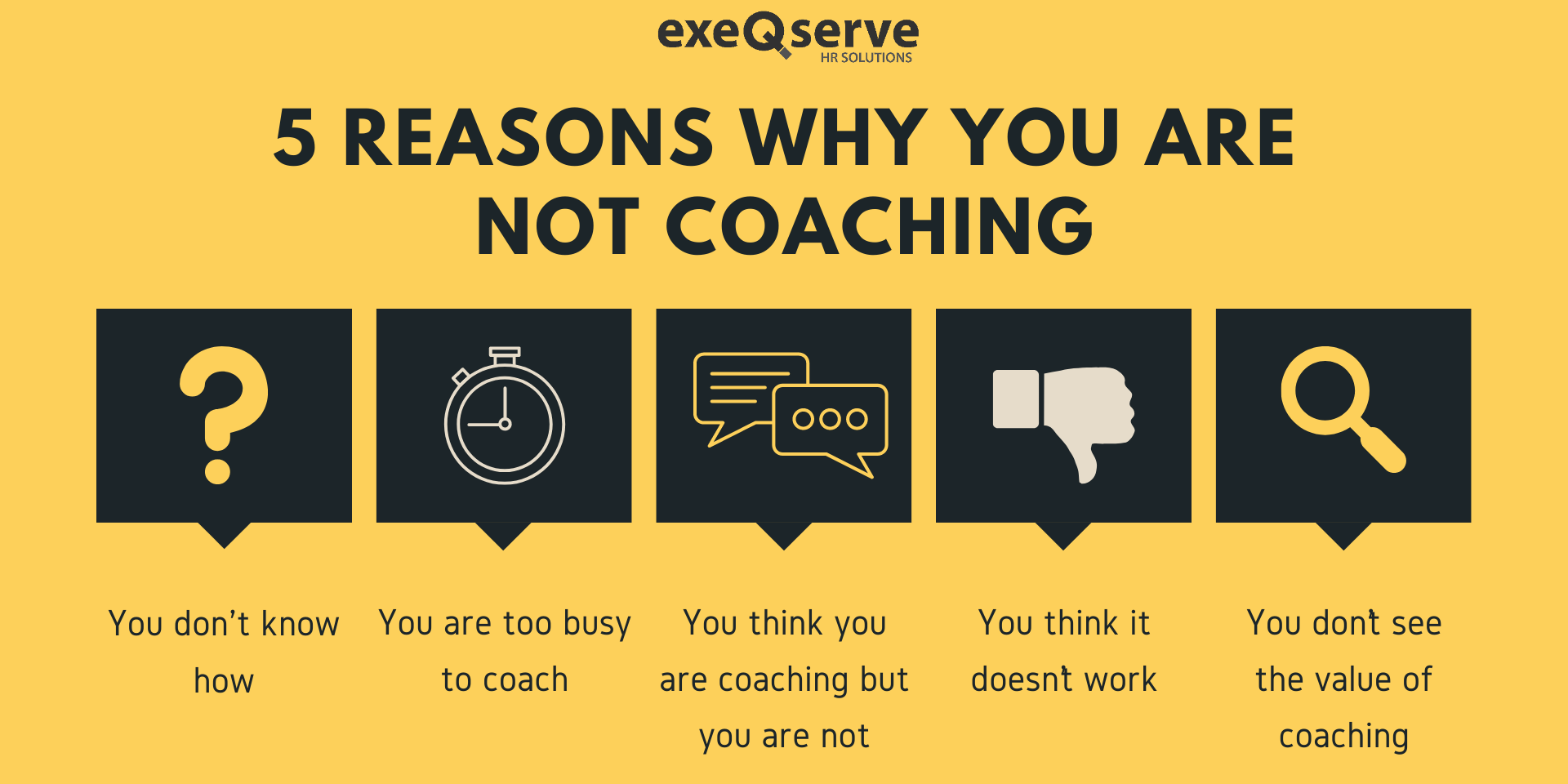Coaching is a valuable talent development skill. Anyone who possesses this skill can help others enhance their capacity to perform, address personal and professional hindrances, and help facilitate the development of others, potentials. Developing one’s coaching skills is one of the most important investments one can make in strengthening one’s leadership capabilities. Despite all the benefits of coaching, however, not a lot of people practice it or practice it well. I noted 5 reasons why people do not coach. Check out this list as it could be your reason too. Also, find out what you can do to remove barriers to effective coaching.
You don’t know how
 Coaching can be a tad overwhelming if you don’t know where to start. Many organizations don’t offer a lot of opportunities for their employees to develop their coaching skills, and for those who do, the programs are not comprehensive enough to help build the learners’ coaching confidence. At exeQserve, we believe that developing both the competence and the confidence for coaching requires a programmatic approach that is not limited to attending a few hours of training. Building leaders’ coaching competence requires a program that promotes regularity of practice and measurement of efforts and results.
Coaching can be a tad overwhelming if you don’t know where to start. Many organizations don’t offer a lot of opportunities for their employees to develop their coaching skills, and for those who do, the programs are not comprehensive enough to help build the learners’ coaching confidence. At exeQserve, we believe that developing both the competence and the confidence for coaching requires a programmatic approach that is not limited to attending a few hours of training. Building leaders’ coaching competence requires a program that promotes regularity of practice and measurement of efforts and results.
You are too busy to coach
 We hear this too often when we run training on coaching. Coaching does require a dedication of a considerable amount of time. Coaches must be committed to the process, and the process requires time for conversations and follow-through. All time spent can be well worth it especially if the coach is a manager or supervisor. This is because coaching leads to better performance and capabilities that enable them to delegate and empower more. Coaching frees up the time of managers to take on the more strategic aspects of their work and do more coaching.
We hear this too often when we run training on coaching. Coaching does require a dedication of a considerable amount of time. Coaches must be committed to the process, and the process requires time for conversations and follow-through. All time spent can be well worth it especially if the coach is a manager or supervisor. This is because coaching leads to better performance and capabilities that enable them to delegate and empower more. Coaching frees up the time of managers to take on the more strategic aspects of their work and do more coaching.
You think you are coaching but you are not
This stems from a lack of understanding of what coaching means and what it looks like. People often mistake supervising for coaching. They think that any kind of conversation that happens between a manager and employee is coaching of some sort. When I ask training participants to describe how they coach, their explanation almost always comes down to giving instructions, advising, or even scolding. Real coaching is neither of those. Effective coaches follow methods that allow coachees to make decisions, and commit to them, which pave the way for better performance. While some people demonstrate the capability to coach naturally, good training on how to coach can help any individual or manager exponentially get better on their coaching activities.
explanation almost always comes down to giving instructions, advising, or even scolding. Real coaching is neither of those. Effective coaches follow methods that allow coachees to make decisions, and commit to them, which pave the way for better performance. While some people demonstrate the capability to coach naturally, good training on how to coach can help any individual or manager exponentially get better on their coaching activities.
You think it doesn’t work
 Many training participants complain that they’ve done it several times and the results are frustrating. I can pick some reasons why this happens; first, the lack of the coach’s skill in coaching; second, the lack of follow-through, and third; we often pick the worst people to coach, those who don’t want it. For coaching to work, you have to build your competence for it, and second, the person you are going to coach must want to be coached. Coachability is an important factor in coaching success.
Many training participants complain that they’ve done it several times and the results are frustrating. I can pick some reasons why this happens; first, the lack of the coach’s skill in coaching; second, the lack of follow-through, and third; we often pick the worst people to coach, those who don’t want it. For coaching to work, you have to build your competence for it, and second, the person you are going to coach must want to be coached. Coachability is an important factor in coaching success.
You don’t see the value of coaching
Some people wrongly think that coaching only benefits the coachees, so if they don’t care much about their potential coachees, they fail to appreciate the worth of the activity. This happens when the relationship between prospective coach and coachee is sour, or if the potential coach doesn’t feel good about sharing their valuable time. What they fail to recognize is that coaching benefits the coach more than the coachee. When you coach you sharpen so many leadership skills, like active listening, empathy, giving feedback, problem-solving, and performance management, and many others. Coaching simply makes you a better leader.
Last piece of advice; know more about coaching, learn how to do it properly, practice it regularly, and see yourself grow as a leader as you facilitate the growth of the people around you.
If you want to build the coaching culture in your organization, check out ExeQserve’s program here.








